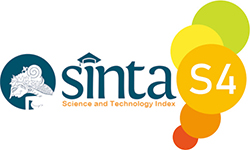STUDY OF METAVERSE: INFLUENCE OF DISCORD VIRTUAL COMMUNITY TO PURCHASE INTENTION OF NON-FUNGIBLE TOKEN (NFT)
DOI:
https://doi.org/10.35794/jmbi.v9i2.41762Abstract
Abstract.  A wide range of NFTs as non-interchangeable token of data saved on a blockchain which are being sold and being widely shared on digital platforms. Having a unique characteristic, NFT branding and its promotional activity to let them know by the public has been done in social media, particularly Twitter as a meaning of public perception building and potential buyers collecting effort. But the author found that the role of company initiated virtual community in Discord has a big impact as it gathers targeted group and building connection between the company and the people who has probability to purchase in the future - that is going to be examined in this research using E-WOM as the mediation. By finishing this study, the author digs into the study of metaverse as the metaverse could be the future development of the Internet based on its tenacious, shared virtual worlds in which people interact as 3D avatars. Blockchain technology may represents the very essence of the metaverse to the fact that linked NFT assets that can be used thorough different metaverse platforms.
Abstrak. Â Â Berbagai macam NFT sebagai token data yang tidak dapat dipertukarkan yang disimpan di blockchain yang dijual dan dibagikan secara luas di platform digital. Memiliki karakteristik yang unik, NFT branding dan aktivitas promosinya untuk diketahui oleh publik telah dilakukan di media sosial, khususnya Twitter sebagai sarana untuk membangun persepsi publik dan upaya pengumpulan pembeli potensial. Tetapi penulis menemukan bahwa peran komunitas virtual yang diprakarsai perusahaan dalam Discord memiliki dampak besar karena mengumpulkan kelompok sasaran dan membangun hubungan antara perusahaan dan orang-orang yang memiliki kemungkinan untuk membeli di masa depan - yang akan diteliti dalam penelitian ini. menggunakan E-WOM sebagai mediasi. Dengan menyelesaikan studi ini, penulis menggali studi tentang metaverse karena metaverse bisa menjadi pengembangan masa depan Internet berdasarkan dunia maya yang ulet dan berbagi di mana orang-orang berinteraksi sebagai avatar 3D. Teknologi Blockchain dapat mewakili inti dari metaverse dengan fakta bahwa aset NFT terkait yang dapat digunakan melalui platform metaverse yang berbeda.
References
REFERENCES
Abedi, E., Ghorbanzadeh, D., & Rahehagh, A. (2020). Influence of eWOM information on consumers’ behavioral intentions in mobile social networks: Evidence of Iran. Journal of Advances in Management Research, 17(1), 84–109. https://doi.org/10.1108/JAMR-04-2019-0058
Abubakar, A. M., Ilkan, M., & Sahin, P. (2016). eWOM, eReferral and gender in the virtual community. Marketing Intelligence and Planning, 34(5), 692–710. https://doi.org/10.1108/MIP-05-2015-0090
Ardian, R., & Sudrartono, T. (2021). Pengaruh Bauran Promosi Terhadap Minat Beli Kembali Cat Dulux Di Depo Keramik Katapang Bandung. JMBI UNSRAT (Jurnal Ilmiah Manajemen Bisnis dan Inovasi Universitas Sam Ratulangi)., 8(3). doi:https://doi.org/10.35794/jmbi.v8i3.35854
Ai, T. (2021). Metaverse theory. SSRN Electronic Journal. https://doi.org/10.2139/ssrn.3840764
Arif, M. E. (2019). The influence of Electronic Word of Mouth (EWOM), brand image, and price on re-purchase intention of airline customers. Jurnal Aplikasi Manajemen, 17(2), 345–356. https://doi.org/10.21776/ub.jam.2019.017.02.18
Arikan, E. (2017). Engagement with online customers in emerging economies: The power of online brand communities and social networking sites. In Promotional Strategies and New Service Opportunities in Emerging Economies (pp. 184–209). https://doi.org/10.4018/978-1-5225-2206-5.ch009
Bueno, A. O., & Anacleto, J. C. (2017). Creating and supporting virtual communities a city that happens on a facebook group. In Lecture Notes in Computer Science (including subseries Lecture Notes in Artificial Intelligence and Lecture Notes in Bioinformatics): Vol. 10282 LNCS (pp. 289–306). https://doi.org/10.1007/978-3-319-58559-8_24
Chohan, R., & Paschen, J. (2021, February). What marketers need to know about Non-Fungible Tokens (NFTs). Business Horizons. https://doi.org/10.1016/j.bushor.2021.12.004
Dwivedi, Y. K., Ismagilova, E., Hughes, D. L., Carlson, J., Filieri, R., Jacobson, J., Jain, V., Karjaluoto, H., Kefi, H., Krishen, A. S., Kumar, V., Rahman, M. M., Raman, R., Rauschnabel, P. A., Rowley, J., Salo, J., Tran, G. A., & Wang, Y. (2021). Setting the future of digital and social media marketing research: Perspectives and research propositions. International Journal of Information Management, 59. https://doi.org/10.1016/j.ijinfomgt.2020.102168
Gadekallu, T. R., Huynh-The, T., Wang, W., Yenduri, G., Ranaweera, P., Pham, Q.-V., da Costa, D. B., & Liyanage, M. (2022). Blockchain for the Metaverse: A review. Computer Science, 1–17. https://doi.org/https://doi.org/10.48550/arXiv.2203.09738
Goetzmann, W. N., Ravid, S. A., & Sverdlove, R. (2013). The pricing of soft and hard information: Economic lessons from screenplay sales. Journal of Cultural Economics, 37(2), 271–307. https://doi.org/10.1007/s10824-012-9183-5
Gupta, S., Kim, H. W., & Shin, S. J. (2010). Converting virtual community members into online buyers. Cyberpsychology, Behavior, and Social Networking, 13(5), 513–520. https://doi.org/10.1089/cyber.2009.0202
Hayward, A. (2022, February). What is the Metaverse? The immersive, NFT-powered future internet. Decrypt. https://decrypt.co/resources/what-is-the-metaverse-immersive-nft-virtual-world
Heath, C., & Luff, P. (2007). Ordering competition: The interactional accomplishment of the sale of art and antiques at auction. In British Journal of Sociology (Vol. 58, Issue 1, pp. 63–85). https://doi.org/10.1111/j.1468-4446.2007.00139.x
Joshi, A., Kale, S., Chandel, S., & Pal, D. (2015). Likert scale: Explored and explained. British Journal of Applied Science & Technology, 7(4), 396–403. https://doi.org/10.9734/bjast/2015/14975
Kapoor, A., Guhathakurta, D., Mathur, M., Yadav, R., Gupta, M., & Kumaraguru, P. (2022). TweetBoost: Influence of social media on NFT valuation. Companion Proceedings of the Web Conference 2022 (WWW ’22 Companion). https://doi.org/https: //doi.org/10.1145/3487553.3524642
Karjaluoto, H., & Leppäniemi, M. (2013). Social identity for teenagers: Understanding behavioral intention to participate in virtual world environment. Journal of Theoretical and Applied Electronic Commerce Research, 8(1), 1–16. https://doi.org/10.4067/S0718-18762013000100002
Kelly, S. M. (2021, October 29). Meta: Facebook changes its company name. CNN Business. https://edition.cnn.com/2021/10/28/tech/facebook-mark-zuckerberg-keynote-announcements/index.html
Khaire, M. (2015). Art without borders? Online firms and the global art market. In O. Velthuis & S. B. Curioni (Eds.), Cosmopolitan Canvases: The Globalization of Markets for Contemporary Art (pp. 102–126). Oxford University Press. https://doi.org/10.1093/acprof:oso/9780198717744.003.0005
Kim, Jihye, Kim, H. M., & Kim, M. (2021). The impact of a sense of virtual community on online community: Does online privacy concern matter? Internet Research, 31(2), 519–539. https://doi.org/10.1108/INTR-01-2020-0015
Kim, Jooyoung. (2021). Advertising in the Metaverse: Research agenda. Journal of Interactive Advertising, 21(3), 141–144. https://doi.org/10.1080/15252019.2021.2001273
Kusumawidjaya, E., Wijaya, V., & Oktavio, A. (2021). Impulsive buying behavior in mobile apps Online Travel Agent (OTA) users: The role of apps browsing and sales promotion. Procedia Business and Financial Technology, 1. https://doi.org/10.47494/pbft.2021.1.4
Liu, C., Bao, Z., & Zheng, C. (2019). Exploring consumers’ purchase intention in social commerce: An empirical study based on trust, argument quality, and social presence. Asia Pacific Journal of Marketing and Logistics, 31(2), 378–397. https://doi.org/10.1108/APJML-05-2018-0170
Mak, H. W., Fluharty, M., & Fancourt, D. (2021). Predictors and impact of arts engagement during the COVID-19 pandemic: Analyses of data from 19,384 adults in the COVID-19 social study. Frontiers in Psychology, 12. https://doi.org/10.3389/fpsyg.2021.626263
Murray, M. D. (2022). NFTs and the art world - What’s real, and what’s not. SSRN Electronic Journal, April. https://doi.org/10.2139/ssrn.4082646
Mystakidis, S. (2022). Metaverse. Encyclopedia, 2(1), 486–497. https://doi.org/10.3390/encyclopedia2010031
Nadini, M., Alessandretti, L., Di Giacinto, F., Martino, M., Aiello, L. M., & Baronchelli, A. (2021). Mapping the NFT revolution: Market trends, trade networks, and visual features. Scientific Reports, 11(1). https://doi.org/10.1038/s41598-021-00053-8
Nafarin, L., & Oktavio, A. (2021). Scarcity marketing to perceived uniqueness and desirability users of the food delivery service Indonesia application. Jurnal Aplikasi Manajemen, 19(3), 483–494. https://doi.org/10.21776/ub.jam.2021.019.03.03
Newzoo. (2021). Global Games Market Report: The VR & Metaverse Edition. https://newzoo.com/insights/trend-reports/newzoo-global-games-market-report-2021-free-version
Nursalin, K., Kristiawan, A., Gunawan, I., & Honggana, H. (2021). Analisa Atribut Pusat Perbelanjaan Paris Van Java Bandung Terhadap Keterlibatan Pengunjung Pusat Perbelanjaan Paris Van Java Bandung. JMBI UNSRAT (Jurnal Ilmiah Manajemen Bisnis dan Inovasi Universitas Sam Ratulangi)., 8(3).
O’Shea, E., & Léime, Ã. N. (2012). The impact of the Bealtaine arts programme on the quality of life, wellbeing and social interaction of older people in Ireland. Ageing and Society, 32(5), 851–872. https://doi.org/10.1017/S0144686X11000717
Park, S. M., & Kim, Y. G. (2022). A Metaverse: Taxonomy, components, applications, and open challenges. IEEE Access, 10, 4209–4251. https://doi.org/10.1109/ACCESS.2021.3140175
Pinto-Gutiérrez, C., Gaitán, S., Jaramillo, D., & Velasquez, S. (2022). The NFT hype: What draws attention to Non-Fungible Tokens? Mathematics, 10(3). https://doi.org/10.3390/math10030335
Piyadigama, D., & Poravi, G. (2022). An analysis of the features considerable for NFT recommendations. Computer Science. https://arxiv.org/abs/2205.00456v1
Sharma, T., Zhou, Z., Huang, Y., & Wang, Y. (2022). “It’s a blessing and a curseâ€: Unpacking creators’ practices with Non-Fungible Tokens (NFTs) and their communities. 1(1). http://arxiv.org/abs/2201.13233
Vladoiu, M., & Constantinescu, Z. (2020). Learning during COVID-19 pandemic: Online education community, based on Discord. Proceedings - RoEduNet IEEE International Conference, 2020-Decem. https://doi.org/10.1109/RoEduNet51892.2020.9324863
Vosinakis, S., & Xenakis, I. (2011). A virtual world installation in an art exhibition: Providing a shared interaction space for local and remote visitors. Proceedings of the Re-Thinking Technology in Museums 2011, 253-264, January, 253–264.









